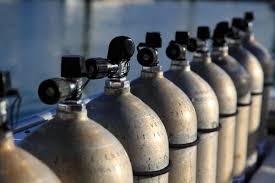Should Open Water Divers Analyze SCUBA cylinders?
Should brand new Open Water SCUBA divers be analyzing their air tanks before a dive?
Analyzing the contents of a SCUBA cylinder is something you should be familiar with if you are Nitrox certified or engage in any technical or mixed gas diving, but it’s almost never taught in the Open Water Diver course. I’ve been thinking about this a lot and keep asking myself… “why”? Many of the same issues that technical divers face can be found on recreational dive boats as well.
First, let’s look at the reasons we analyze breathing gases in SCUBA diving. Every breathing gas, be it Air, Nitrox 32, 18/45 Trimix or anything in between, has a Maximum Operating Depth, or for short, MOD. Breathing any gas below its MOD can lead to a host of problems including Oxygen Toxicity and Gas Narcosis. This chart shows the commonly accepted MOD for specific blends of Nitrox up to 50%.
Staying above the MOD of the gas you are breathing is a HARD rule in SCUBA diving.
An Open Water SCUBA certified Diver will most likely be diving Air as their breathing gas. According to the MOD chart , Air has a MOD of 186’. Since the Open Water Diver course limits depth to a maximum of 60’, why in the world would one be concerned with this when planning a 50’ dive on a coral reef? Diving to 187’ where the MOD of Air is exceeded is not even on the radar, and besides, the deepest water on the dive is 60’ so it’s physically impossible to violate the MOD of Air.

Analyzing and marking a cylinder is a final safe guard against breathing the wrong gas on a dive.
While 187’ is a very deep dive, and you physically can not take the breathing gas beyond 60’ due to the depth of the water, there is still one more factor to consider… Human Error. People can, and do, make mistakes filling, analyzing, and labeling SCUBA cylinders. What this MOD chart doesn’t show you is the MOD for higher Oxygen percentages. Since pure Oxygen is used at almost every dive shop, and Nitrox mixtures above 50% are commonly blended for technical and rebreather divers, it is worth noting that the MOD of 100% Oxygen is 20 ft. What if a mistake was made at the fill station and allowed a high oxygen content gas into your “Air” cylinder? It would NOT be good! While rare, accidents do happen. Fill station equipment can malfunction or be improperly calibrated. Many SCUBA cylinders look similar, it’s easy to pick up the wrong one.

Many scuba cylinders look the same, analyzing and marking your cylinder ensures you dont accidentally pick up the wrong one.
